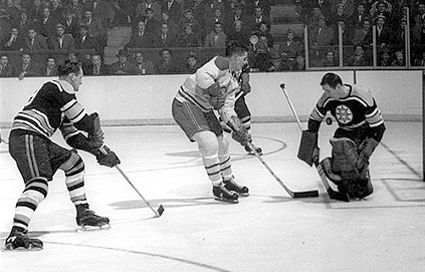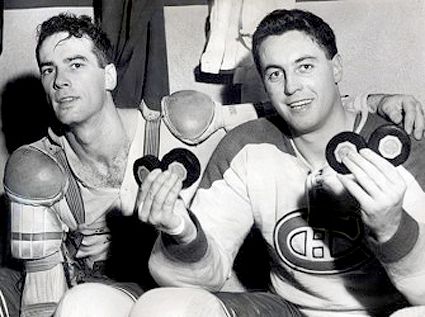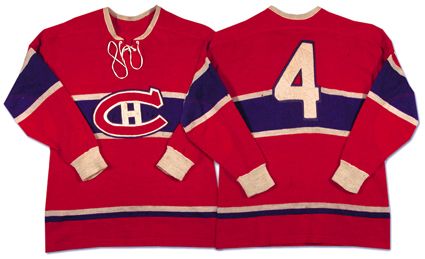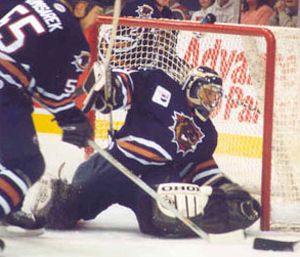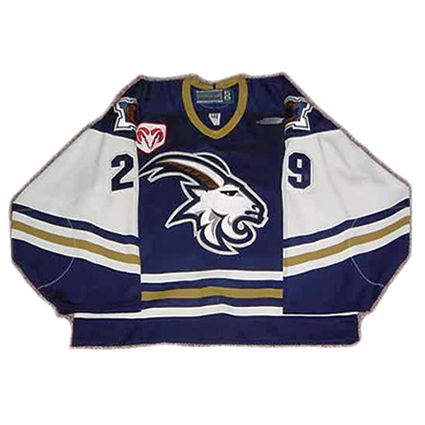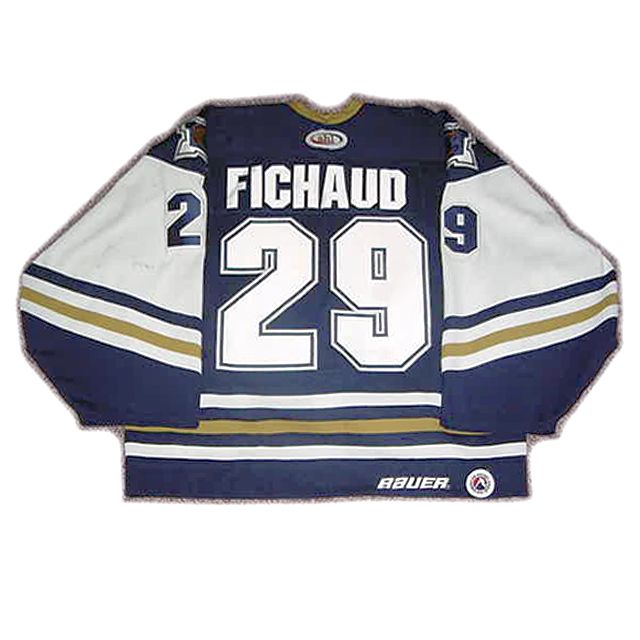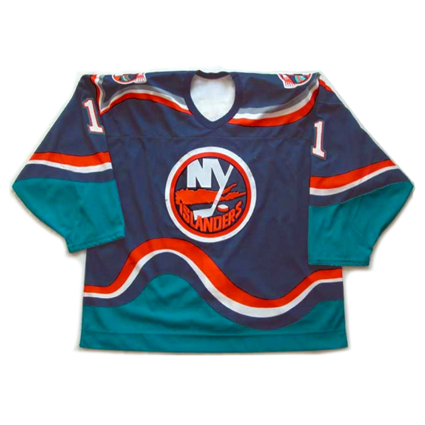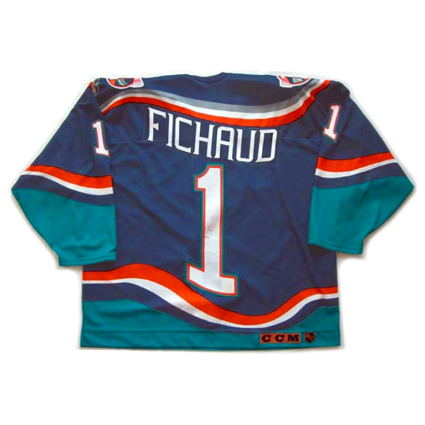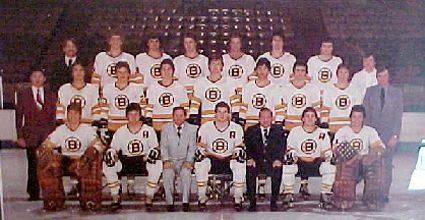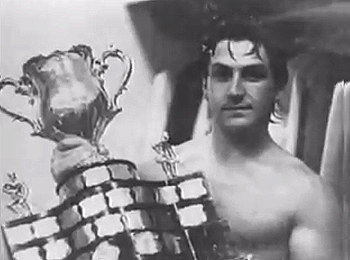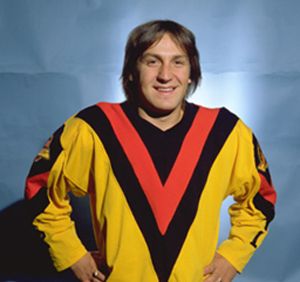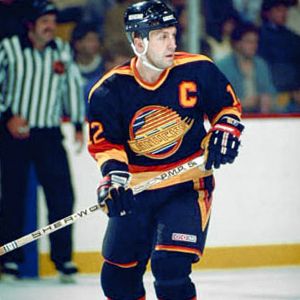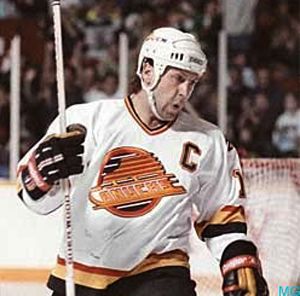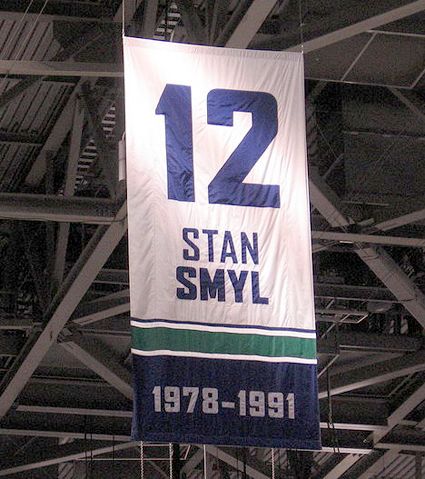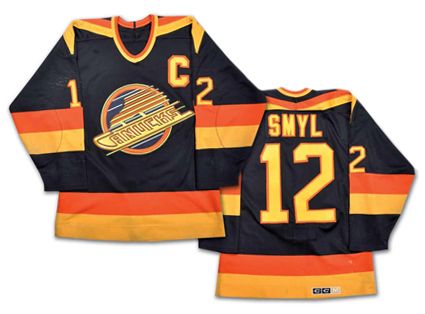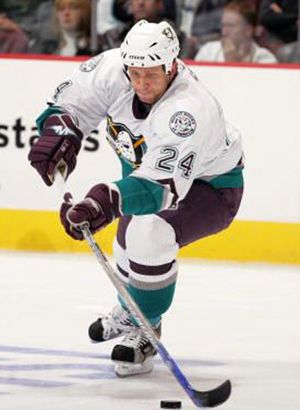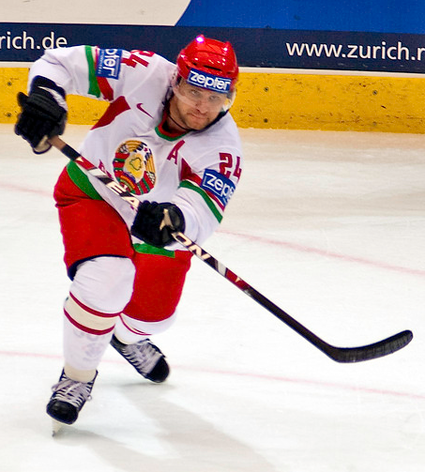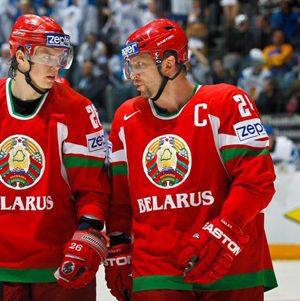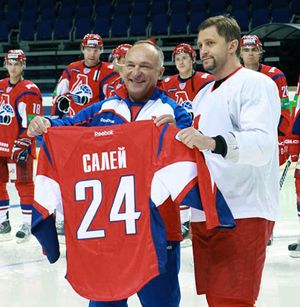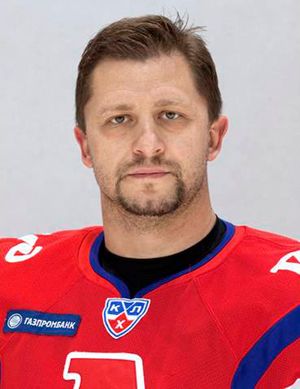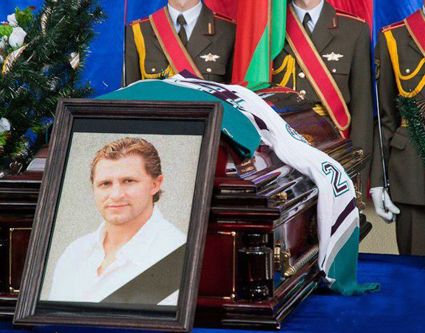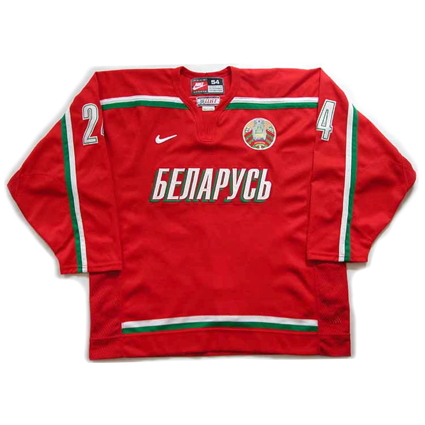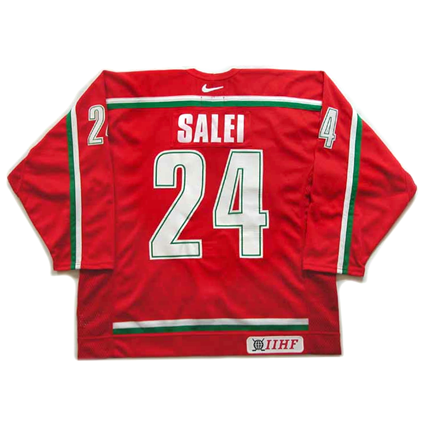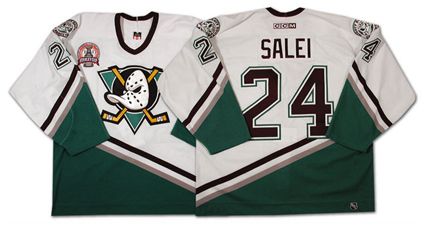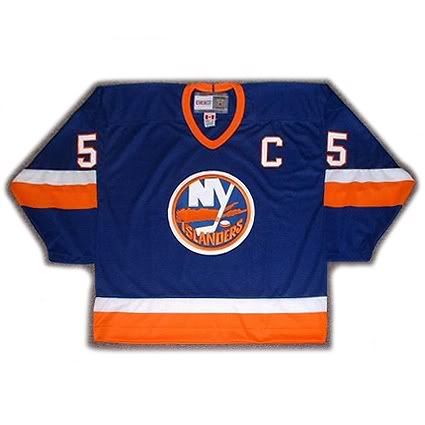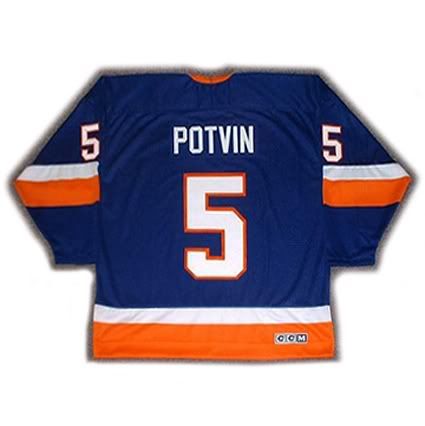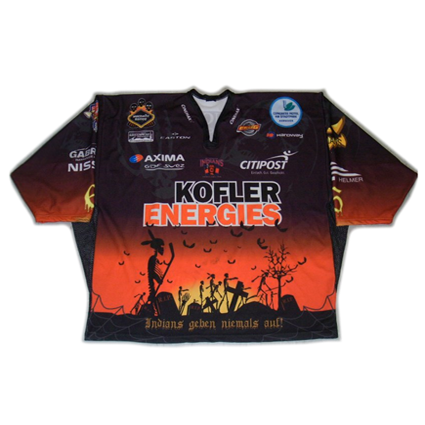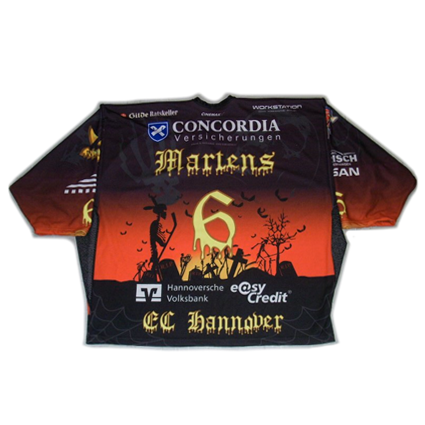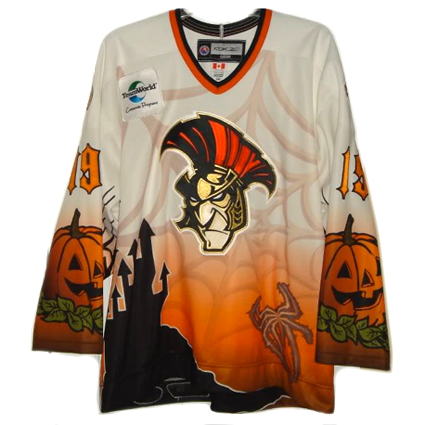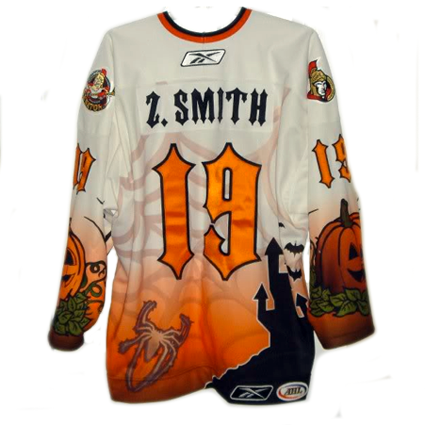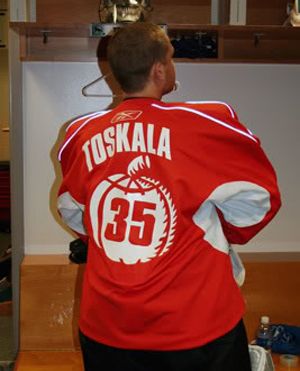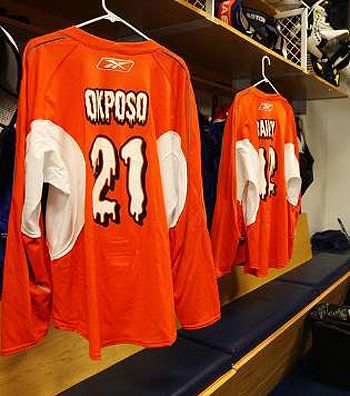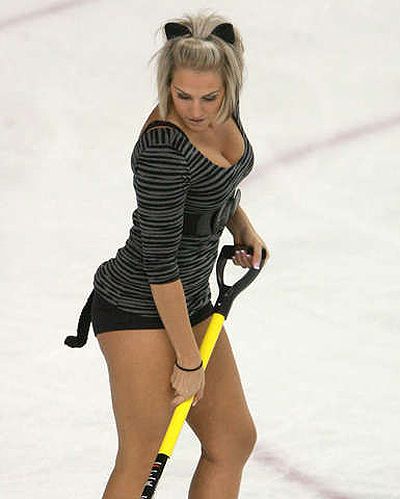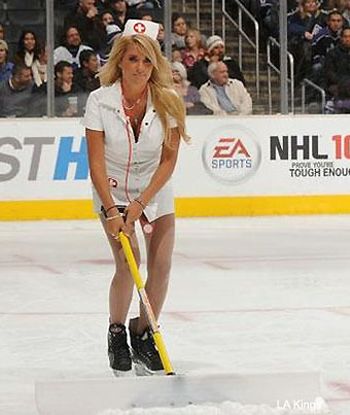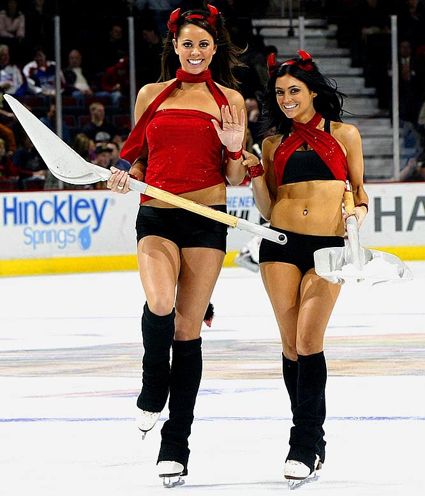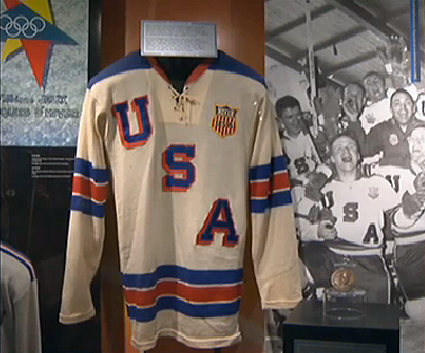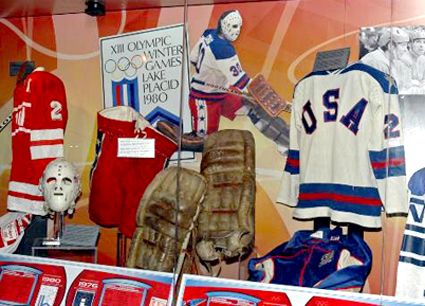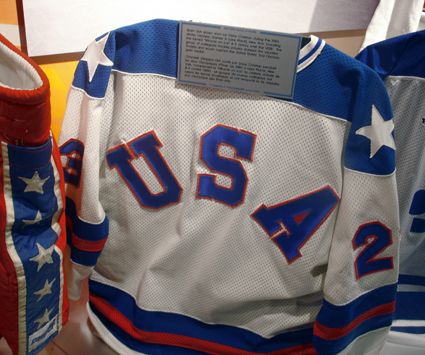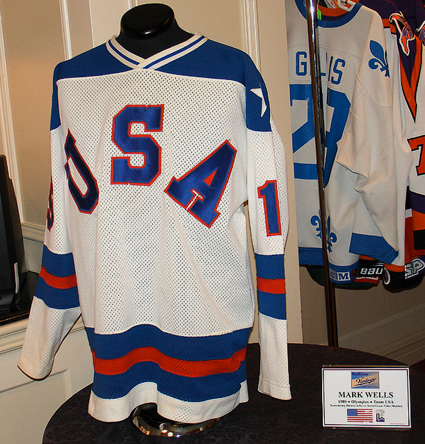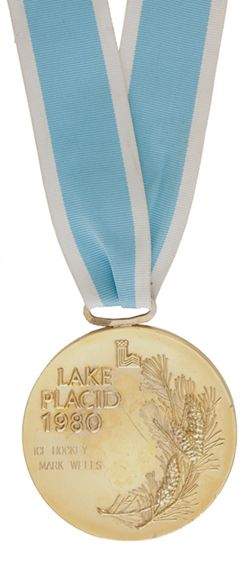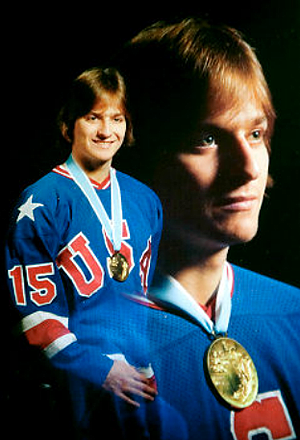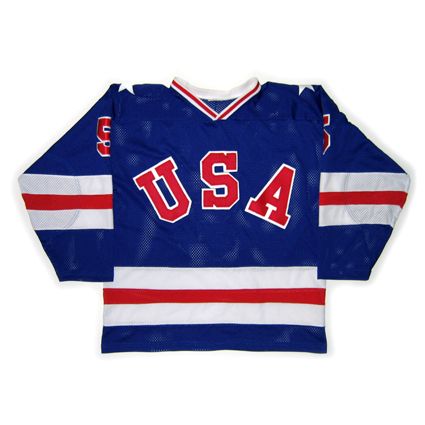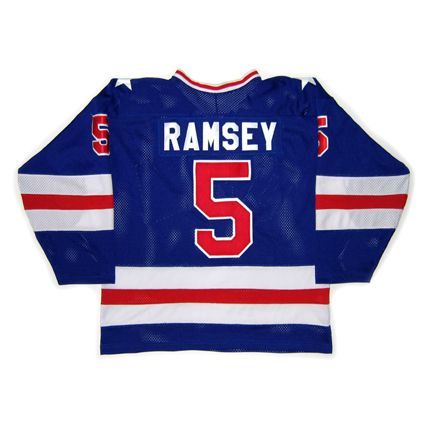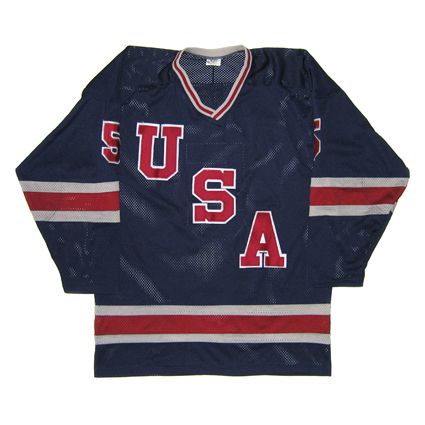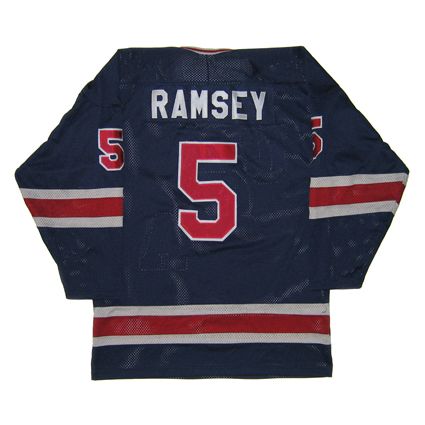Saturday, November 5, 2011
1955-56 Montreal Canadiens Jean Beliveau Jersey
On this date in 1955, the Montreal Canadiens and Boston Bruins squared off at The Forum in Montreal.
The Bruins jumped out to an early lead with an even strength goal by Leo Boivin at 1:35 of the first period. Before the period would end, Doug Mohns would add to the Bruins advantage with a power play goal at the 18:12 mark. Before the period would end, Cal Gardner of Boston would be whistled for a penalty with just ten seconds remaining that would put Montreal on the power play to start the second period.
With Montreal already with a man advantage, Hal Laycoe would be called for a penalty at the 16 second mark that would change the way the game would be played forever more. The Canadiens relished any opportunity to play with a man advantage, for the previous season they led the league in goals with 228 in 70 games, the only team to average more than 3 per game and 24 more than their closest pursuer thanks to their notoriously potent power play.
Montreal controlled the puck following the face-off and Doug Harvey fed Bert Olmstead who got the puck to center Jean Beliveau who redirected it past Bruins goaltender Terry Sawchuk at the 42 second mark to cut the Bruins lead to 2-1.
After the ensuing face-off, with Montreal still on the power play, Maurice Richard worked to get the puck to Olmstead, who again fed Beliveau who again beat Sawchuk on a similar play just 26 seconds later to even the score at 2-2.
Now, in this day and age, the first Montreal goal would have freed Gardner from the penalty box while the second tally would have set Laycoe free, ending the Montreal man advantage, but this was not the case back in 1955, as any penalized player was required to serve the full length of his penalty, regardless of how many goals were scored while his full time was being served.
So, with both Gardner and Laycoe still serving their full sentence with no parole in the offing, Montreal remained on a two-man advantage with 42 second remaining. After controlling the puck once again, Harvey again found Olmstead who knew exactly what to do with it - get the puck to Beliveau. "Le Gros Bill" found the twine to complete his hat trick at 1:26, his third goal with the two man advantage in the span of just 44 seconds!
Gardner was finally able to escape the penalty box 24 seconds later after having to helplessly watch the carnage created by his departure, and Laycoe's freedom finally arrived 26 seconds later, but not until he was forced to watch a 2-0 Boston lead turned into a 3-2 lead for the Canadiens while he was away.
While there were no further power play goals during the contest, Beliveau would score his fourth goal of the night at 15:53 of the third period at even strength, assisted by Olmstead once again and Bernie Geoffrion for a final score in favor of Montreal 4-2 thanks to the talents of Beliveau and the remarkable Canadiens power play.
Beliveau displays the four pucks from his stellar evening and is joined by Olmstead, who assisted on all four goals
Beliveau would go on to go on to win the Art Ross Trophy as scoring champion and the Hart Trophy as league MVP at the conclusion of the season, thanks in part to the opportunity to score multiple goals on a single power play.
Such was the dominance of the Montreal power play, having scored more than once with the man advantage eight times that season, that a new rule was put into effect in time for the start of the 1956-57 season to minimize the distinct offensive advantage enjoyed by the Canadiens, as any penalized player serving a two-minute minor would be freed immediately following any goal scored against his team in an effort to keep games more competitive. Predictably, the vote was 5-1 in favor of the new rule change.
While Montreal was able to capture the Stanley Cup in 1956 with the ability to score seemingly at will with the man advantage, how did the new rule affect the competitive balance for the time period immediately after the new rule was put into effect? Very little, in fact, as the Canadiens would reel off four more consecutive titles from 1957 to 1960 for a dynasty like no other, as no team before or since would ever win five consecutive Stanley Cups.
Today's featured jersey is a 1955-56 Montreal Canadiens Jean Beliveau jersey. Believau was a ten time Stanley Cup champion with Montreal in his 20 years with the club. In addition to the Conn Smythe, Beliveau also won the Art Ross Trophy as scoring champion in 1956 and the Hart Trophy as MVP in 1956 and 1964. Had the Conn Smythe Trophy been in existence prior to the 1965 finals, odds are that Beliveau would have won at least one other one, particularly in 1956 when he led the Canadiens in playoff scoring with 12 goals and 19 points in just ten games.
This exact variation of the Canadiens jersey arrived in 1947 when the red shoulders no longer encroached into the blue arm stripes and would be worn until 1956 when further detail changes were introduced.
Today's video selection is the wonderful Legends of Hockey profile of Jean Beliveau.
Labels:
Beliveau Jean,
Montreal Canadiens
Friday, November 4, 2011
1999-00 Quebec Citadelles Eric Fichaud Jersey
Born on this date in 1975, Eric Fichaud played his junior hockey with the Chicoutimi Sagueneens of the Quebec Major Junior Hockey League beginning in the 1992-93 season. After posting a record of 18-15-1, he took the undisputed number one role in 1993-94, and in 63 starts, went 37-21-3. He backstopped the Sags to the QMJHL championship after winning 16 of 26 playoff games to earn the club a spot in the Memorial Cup.
Following the season Fichaud was drafted 16th overall by the Toronto Maple Leafs before returning to Chicoutimi for one final season during which he recorded his third consecutive winning season with a 21-19-4 mark.
The Maple Leafs traded Fichaud to the New York Islanders at the 1995 draft and he spilt the 1995-96 season between the Worcester Ice Cats of the AHL and the Islanders, who were in a decidedly down period at the time. Fichaud's rookie season ended with a 7-12-2 record, but a respectable 3.31 goals against average.
His second season on Long Island saw his games played increase from 24 to 34 as he complied a 9-14-4 record while lowering his goals against average to 3.10. Following the season he was selected to join Team Canada for the 1997 World Championships, but did not see any action.
Fichaud saw limited playing time in 1997-98 thanks to a shoulder injury, playing 17 games with the Islanders, finishing with a 3-8-3 mark but lowering his GAA once more, down to 2.97, and a single game with the Utah Grizzlies of the IHL.
During the off season, he was dealt to the Edmonton Oilers in June, only to have the Oilers deal him to the Nashville Predators in early October. He once again saw little ice time, playing 8 games with Milwaukee (5-2-1) and a forgettable 9 games with the Predators, going 0-6-0 while competing for playing time with Mike Dunham and Tomas Vokoun.
His next stop was with the Carolina Hurricanes, where once more ice time was at a premium. 9 games with Carolina ended with his release and he was claimed by the Montreal Canadiens who assigned him to the Quebec Citadelles of the AHL, where he performed well with a 4-1-1 mark.
He finally got his first regular ice time in four seasons in 2000-01 with the Citadelles, seeing action in 42 games and finishing with a 19-19-2 record.
For the 2001-02 season, Fichaud started the year with the Manitoba Moose, but was granted his release by the Moose after just 5 games in three months. He signed with the Krefeld Penguins of the German DEL and played in 9 regular season games as well as 3 playoff contests.
Back in North America for the 2002-03 season, Fichaud played with the Hamilton Bulldogs, the top affiliate of the Oilers. He had a good season with a strong Bulldogs club, splitting time with Mathieu Garon and Ty Conklin on his way to 27 appearances and a 14-7-3 mark with 4 shutouts, his highest total since juniors. He also played in 8 playoff games with a 5-3 record as Hamilton made it to the Calder Cup Finals.
He was back for a second season with the Bulldogs, only now part of the Canadiens organization, and in 31 games went 16-11-3.
Beginning with the 2004-05 season, Fichaud started a three year run with Quebec RadioX (named after a radio station owned by the team's owners) of he lower level Ligue Nord-Americaine de Hockey after it elevated itself from being an amateur league. The 2004-05 season was the missed NHL season due to the lockout, and with hundreds of pros looking for work in Europe and many younger NHLers keeping busy in the AHL, work was hard to come by for many, who saw the LNAH as an alternative. It paid off, as RadioX won the league championship in 2005 thanks in part to Fichaud's 8-0 record during the playoffs.
After two more seasons with Quebec, Fichaud played one final season in 2007-08 with the St. Georges CRS Express.
Today's featured jersey is a 1999-00 Quebec Citadelles Eric Fichaud jersey as worn during his first season with the Canadiens AHL affiliate.
This attractive jersey features the unusual choice of a goat head for the team's logo, which was the mascot of the Royal 22nd Regiment, which was stationed in the Citadel of Quebec. The team played in Quebec for just three seasons before relocating to Hamilton where they were renamed the Bulldogs.
A well travelled franchise, it began in 1969 in Montreal as the Voyageurs before moving to Nova Scotia, then Sherbrooke, Quebec and then Frederiction before relocating for the fourth time to Quebec.
Bonus Jersey: Today's bonus jersey is a 1997-98 New York Islanders Eric Fichaud jersey. The Islanders new ownership, in an effort to attract new, younger fans to the downtrodden Islanders scrapped their traditional sweaters, which only happened to have been worn not only since the club's inception in 1972, but also for the length of their Stanley Cup dynasty, and introduced their new jerseys for the 1995-96 season.
As the team wallowed in the depths of the NHL standings and traded away fan favorite Pierre Turgeon for the disgruntled Kirk Muller, the fan base immediately made the new jerseys, and specifically their new fisherman logo, the focus of their growing unhappiness. The fate of the jersey was not made any better when the rival New York Rangers fans began to mock the new jerseys with chants of "We want fishsticks! We want fish sticks!" in reference to the new logo's resemblance to the Gorton's Fisherman logo.
The Islanders adopted a hybrid jersey for 1996-97 with the original Islanders logo placed on the "wave" style jersey as an alternate style. For 1997-98, the fisherman was gone and the hybrid jersey was used full time. In 1998-99, a modern version of the Islanders jersey debuted as the wave style was scrapped permanently.
Today's video selection is a slideshow of images from Fichaud's career, which documents many of the jerseys he wore during his career.
Labels:
Fichaud Eric,
New York Islanders,
Quebec Citadelles
Thursday, November 3, 2011
1987-88 Vancouver Canucks Stan Smyl Jersey
Stan Smyl first played junior hockey with the Bellingham Blazers of the British Columbia Junior Hockey League in 1974-75. He led the club to the Fred Page Cup with 33 points in 25 playoff games. He then joined the New Westminster Bruins of the Western Canada Hockey League for three playoff games later that same season before joining the team full time in 1974-75.
Smyl would be a force with the Bruins as the winger would score 32 goals and 74 points while compiling 169 penalty minutes in 72 games. The Bruins would go on to win the WCHL playoff title and advance to the Memorial Cup Final.
He would raise his goal total to 35 and his penalty minute total to 200 in 1976-77. Again, the Bruins would win the WCHL playoffs and return to the Memorial Cup, where they would emerge victorious following a 6-5 win over the Ottawa 67's.
His third season with the Bruins would raise his stock with the NHL scouts, as he set a new personal best with 76 points despite being limited to just 53 games. Once again the Bruins won the WCHL playoffs and returned to defend their championship, their fourth straight Memorial Cup appearance and Smyl's third. Smyl put on a clinic during the playoffs, scoring 14 goals and 35 points in 20 playoff games (including 14 in the 5 games of the Memorial Cup) as the Bruins successfully defended their championship with a 7-4 win over the Peterborough Petes as Smyl was named the Memorial Cup MVP.
Earlier that same season, Smyl made his debut for Canada at the 1978 World Junior Tournament, earning a bronze medal.
Following the season, Smyl would be taken 40th overall by the Vancouver Canucks in the 1978 NHL Amateur Draft and then appeared in 62 games for the Canucks, scoring 38 points as a rookie.
In 1979-80, Smyl left no doubt he belonged in the NHL, as he averaged a point per game with 78 points in 77 games to lead the Canucks in scoring as well as leaving no doubts about his toughness with 204 penalty minutes. He also set a Canucks record with a 12 game point scoring streak and recorded his first NHL hat trick on March 7th.
He played in all 80 games in 1980-81 while scoring 63 points. For the 1981-82 season, he again played in all 80 games while equalling his high of 78 points, which included a new personal best of 34 goals. Late in the season he was named team captain, a position he would hold for the next eight years. The Canucks would qualify for the playoffs despite a losing record and go on to sweep the Calgary Flames in 3, oust the Los Angeles Kings in 5 and defeat the Chicago Black Hawks in 5 to make it to the Stanley Cup Finals only to face the powerful New York Islanders in the third season of their four year dynasty.
As captain, Smyl thrived, setting career highs in 1982-83 in goals (38), assists (50) and points (88) to not only lead the club in scoring for the second time, but also set a franchise record for most points in a season while also bettering his own team record with a 13 game point scoring streak in the process.
During the 1984-85 season, Smyl would become the Canucks all-time leading goal scorer as he would pass Don Lever with his 187th goal. With Vancouver missing the playoffs for the first time since Smyl's arrival, he was available to participate in the World Championships for Canada for the only time in his career, scoring a goal in ten games, which would be the game winner in a 3-1 victory over the Soviet Union on the way to a silver medal.
Despite suffering a late season season knee injury in 1985-86, Smyl was still able to keep his streak of seven seasons of 60 points or more alive on his way to earning his third Cyclone Taylor Award as Cancuks MVP, with the other two coming in 1980 and 1983.
Smyl would set a Canucks record for games played, passing Harold Snepsts on November 5, 1986 when he appeared in his 648th game. Five weeks later, he became the Canucks career point leader in style, recording a hat trick to give him 551 points to pass Thomas Gradin. While he failed to reach 60 points, he did record 20 goals for the eighth consecutive campaign.
Smyl would play four more seasons for Vancouver to close out his career as the Canucks leader in goals (262), assists (411), points (673) and games (896). While his offensive numbers would decrease dramatically near the end of his career, he was still a valuable player thanks to his defensive skills and relentless checking as well as his leadership.
He would later become the first Canucks player to have his jersey number retired on this date in 1991 when his #12 was raised to the rafters.
Today's featured jersey is a 1987-88 Vancouver Canucks Stan Smyl jersey. Smyl's rookie season was the first for the Canucks new black, orange and yellow "flying V" jerseys, which lasted until 1985, when today's featured style was introduced. These jerseys took on a somewhat more traditional approach, with the team logo as the main crest and a return to classic arm and waist striping.
Still, the Canucks bold colors still remained, standing out against a sea of reds and blues in the NHL, and they were one of only two teams, with the Kings being the other, to have yellow/gold home jersey rather than the traditional white.
These jerseys would remain in use for four seasons through the 1988-89 season when the home jersey returned to being white and the bold shoulder V striping was removed in a jersey makeover for the final three seasons of Smyl's career.
Today's video section begins with a look at Smyl's career as one of the greatest Canucks ever.
Next, a commercial for Stan Smyl night.
Finally, a look back at the New Westminster Bruins of 1977, which includes and interview with Smyl.
Labels:
Smyl Stan,
Vancouver Canucks
Wednesday, November 2, 2011
2004 Belarus National Team Ruslan Salei Jersey
After beginning his career with his hometown Russian Superleague club Dynamo Minsk of Belarus in 1992-93, defenseman Ruslan Salei, born on this date in 1974, played two more seasons with the club, then renamed Tivali Minsk, until taking the opportunity of the recently changed political landscape to come to North America and try to gain the attention of NHL scouts.
He signed with the Las Vegas Thunder of the International Hockey League for the 1995-96 season. While never an offensive force, he did surpass any offensive output he managed in Russia, thanks in part to the longer North American professional season, when he scored 7 goals and 30 points, five times more than the high of 6 he managed the year before in 51 games. In addition, he also showed his rugged side by accumulating 123 penalty minutes. All of this led to his being drafted 9th overall in the 1996 NHL Entry Draft by the Mighty Ducks of Anaheim.
His next season was divided between the Thunder (8 games), the Baltimore Bandits of the American Hockey League (12 games) and making his NHL debut with Anaheim (30 games), which included Salei scoring his first NHL point with an assist.
For 1997-98, Salei spent the vast majority of his season with the Mighty Ducks, which included his scoring 5 goals and 15 points in 66 games. He also skated for the Cincinnati Mighty Ducks of the AHL in six games that same season.
He would spend the entire 1998-99 season with Anaheim, playing in 74 games as well as seeing his first playoff action in three games during the postseason. While certainly not a flashy offensive defenseman, he became a fan favorite for his grit, nastiness and determination.
After four more seasons, the Mighty Ducks would go on their first extended playoff run, making it all the way to the Stanley Cup Finals, thanks to their solid defensive corps, consisting of Niclas Havelid, Keith Carney, Sandis Ozolinsh, Salei, Vitali Vishnevsky and Kurt Sauer playing in front of Conn Smythe Winner Jean-Sebastien Giguere. The Mighty Ducks gave up just 6 goals in 4 games while sweeping Detroit in Round 1, eliminated Dallas in six, miraculously gave up just a single goal to Minnesota as they were swept in four and took the New Jersey Devils to seven games in the finals as Giguere finished the postseason with five shutouts.
The highlight of not only the playoffs, but perhaps his entire career, was Salei winning Game 3 of the finals for the Mighty Ducks with his overtime goal in Game 3 against Martin Brodeur.
After the 2003-04 season with Anaheim, Salei would travel to Russia to play with Ak Bars Kazan of the Russian Superleague during the NHL lockout of 2004-05. He returned to Anaheim for one final season when the NHL resumed play in 2005-06, which included his setting a new NHL high with 19 points.
Salei left the Mighty Ducks after nine seasons to sign a free agent contract with the Florida Panthers. The change in scenery led to a change in Salei's game, as he immediately surpassed his previous offensive totals by a large margin, setting career highs with 6 goals and 26 assists for 32 points, the only time in his NHL career he would exceed 23 points.
After a second season in Florida, he was dealt at the trading deadline (for former teammate Ozolinsh) to the Colorado Avalanche for the final 17 games of the season.He would play another season for Colorado, surpassing 20 points for only the third time, the other being his second season in Florida.
He suffered a serious back injury early in 2009-10, which limited him to just 14 games for the season. The 2010-11 season saw him reunited with his former Mighty Ducks coach Mike Babcock, this time with the Detroit Red Wings. Showing his back issues were behind him, he competed in 75 regular season games as well as 11 playoff contests.
His final NHL totals after 14 seasons of play were 917 games played with 45 goals and 159 assist for 204 points and 1,065 penalty minutes.
Internationally, Salei was a stalwart on the Belarus blue line. The Belarusians first competed internationally at the 1994 World Championships at the Group C level, where they came second to fellow newcomers Slovakia. The won Group C in 1995 with a 4-0 record (while outscoring their opponents 19-8) and were promoted to Group B.
Salei returned to the national team in 1996 and 1997 to help them qualify for the 1998 Olympics in Japan, the first to feature NHL stars, which included a record 21-0 win over Lithuania. Once in Japan, Salei and Belarus won their preliminary round group to advance to the first round, only to be grouped with powerhouses Canada, Sweden and the United States. He also scored his first Olympic goal during
Later that same spring, Belarus, now having been promoted to the top level Group A, advanced to the second round, having finished second to the Czech Republic in Group 1 thanks to wins over Germany and Japan.
He made his next international appearance at the 2000 World Championships, which was highlighted with wins over Ukraine, a shocking 1-0 shutout of Russia and a 5-3 win over Switzerland. Salei and Belarus did not fare as well in 2001, as they finished 14th, usually enough to avoid relegation, but with Japan being protected as the Far Eastern qualifier despite finishing dead last, Belarus were relegated to Division I.
Salei made his second Olympic appearance in 2002 and scored 2 goals in 6 games as Belarus became the Cinderella story of the games. First, they needed to win Group B of the Preliminary Round to advance to the First Round, where they lost three straight games to the United States, Finland and Russia. Still, all eight remaining teams advanced to the Quarterfinals where Belarus shocked the world with their stunning 4-3 defeat of Sweden thanks to Vladimir Kopat's shot from center ice which careened off of Swedish goaltender Tommy Salo's head and into the net with less than 2 and a half minutes remaining.
In 2004, Salei helped Belarus steamroll the opposition in Division I Group A with 3 goals and 7 points for his highest scoring international tournament ever, as they went 5-0 while outscoring their competition 34-9 to return to the Top Level, where they remain to this day.
After two games in an unsuccessful Olympic qualification attempt in 2005, Salei returned to the World Championships in 2008 and again in 2009 where he scored 2 goals and 5 points while serving as team captain.
Salei participated in the third Olympics of his long international career in 2010 in Vancouver. Three months later, Salei made his final international appearance as he took part in his 9th World Championships in Germany, where he scored a goal, the 13th of his career for Belarus. In all, he would play in 69 games and score 31 points in 14 tournaments.
For the 2011-12 season, Salei signed with Lokomotiv Yaroslavl of the Kontinental Hockey League.
As the team were leaving to play their first game of the season, scheduled back in Salei's hometown of Minsk, Belarus, their plane crashed on takeoff, killing Salei and all but one of his 25 teammates, who then died five days later. Additionally, 11 team staff members and 7 of the 8 of the plane's crew also perished. The crash resulted in Lokomotiv bypassing their participation in the KHL season and a moving tribute to Lokomotiv on the ice in Minsk the following day.
This season, tributes to Salei include former Detroit teammate Pavel Datsyuk wearing Salei's #24 during the preseason, the Red Wings honoring Salei on their patch which also includes Brad McCrimmon and Stefan Liv and the Ducks wearing Salei's #24 all season long.
At his funeral, Salei's coffin was draped with his Mighty Ducks jersey.
Today's featured jersey is a 2004 Belarus National Team Ruslan Salei jersey as worn in Salei's participation at the World Championships B Pool tournament when Salei had his highest offensive output in an international tournament with a career high 3 goals and 4 assists for 7 points.
Belarus' National Team first began play in 1994 in the C Pool. It took them two tries to elevate themselves to the B Pool and two more to rise to Group A in 1997. After being relegated in 2001, the earned immediate promotion back to the Top Level in 2002. They were again relegated in 2003 thanks to Japan being exempt from relegation. Once gain they earned an immediate promotion back to the top in 2004 and have remained there ever since, which included an all-time high finish of 6th in 2006, thanks to wins over Slovakia, Kazakhstan, Ukraine and Switzerland on their way to finishing with a 4-3 record.
The original version of today's featured jersey was crested with "Belarus" in English, which was later changed to Cyrillic in 2002.
Bonus Jersey: Today's bonus jersey is a 2002-03 Mighty Ducks of Anaheim Ruslan Salei jersey in which he scored the game winning goal in overtime of Game 3 of the Stanley Cup Finals, as evidenced by the 2003 Finals patch on the upper right chest.
Today's video highlights begin with Salei winning Game 3 of the 2003 finals for Anaheim with his goal in overtime, just one of 5 playoff goals he would ever score with the Mighty Ducks.
Here are a pair of tributes to Salei, which include footage from his various NHL teams as well as playing for Belarus.
Labels:
Belarus,
Mighty Ducks of Anaheim,
Salei Ruslan
Tuesday, November 1, 2011
1987-88 New York Islanders Denis Potvin Jersey
On this date in 1987 the New York Islanders Denis Potvin played in his 1000th NHL game.
Potvin was drafted by the Islanders first overall in the 1973 NHL Entry Draft and immediately the Montreal Canadiens offered a package of established players in exchange for Potvin. Thinking long-term, Islanders general manager Bill Torrey turned down the offer, keeping the man who would eventually become their longest serving captain in franchise history.
Following his final season in juniors for the Ottawa 67's when he had 123 points and 232 penalty minutes in just 61 games on defense, Islander fans were expecting much from the rookie, who suffered the pressure from comparisons to Bobby Orr.
Potvin's first campaign saw him play 77 games and score 54 points and added an element of toughness with 175 penalty minutes and earn the Calder Memorial Trophy.
In addition to his standout defense, his offensive numbers would continue to climb, with 76 points in his second season followed by a jump to 98 in 1975-76, beginning a run of seven straight seasons of averaging over a point per game, a season that would see him earn the first of three Norris Trophies.
Three seasons later, in 1978-79, he would have the finest offensive season of his career with 31 goals, 70 assists and 101 points, all career highs, and he would win his third Norris Trophy, having also been named the winner in 1978 as well. He was the first defenseman to score 30 goals and 100 points since Orr in 1975.
Still, the best was yet to come for the Islanders and Potvin, who was named team captain in time for the 1979-80 season. Deep playoff runs in the previous five seasons gave the club experience that they put to good use, capturing the Stanley Cup first in 1980 and then earning the "dynasty" tag by repeating the feat three more seasons in a row, all with Potvin as the captain.
All told, Potvin competed in an astounding 34 playoff rounds in ten consecutive seasons while the Islanders were at their peak, the rough equivalent of two additional seasons worth of games, only played at the highest levels of pressure and emotion.
When he retired after the 1987-88 season, he did so as the NHL leader in goals and points by a defenseman. His final career totals stand at 1060 games played with 310 goals and 742 assists for 1052 points. He also retired with as the career playoff leader in goals (56), assists (108) and points (164) for a defenseman.
His #5 was retired by the Islanders in 1992, the first Islander to ever have his number retired. Prior to that he was elected to the Hockey Hall of Fame in 1991, but perhaps his most enduring legacy might be the "Potvin sucks!" chants that continue to this day in Madison Square Garden, home of the rival New York Rangers.
Today's featured jersey is a 1987-88 New York Islanders Denis Potvin jersey as worn the season he played in his 1000th game on this date.
This jersey style is truly "the jersey that wouldn't die", as the Islanders have tried again and again to redesign their jerseys, first with disastrous results in 1996, before returning with an updated version in 1998. Even after the league wide change to Reebok jerseys in 2007, the Islanders again reintroduced this style as an alternate in 2008, this time with a tie-neck collar as originally worn in 1972, and then promoted that alternate to once more be the team's primary jersey beginning with the 2010-11 season.
First today is a profile of Potvin from the fantastic "Legends of Hockey" series. Love him or hate him, this is well worth watching.
Here is the dramatic finish to the Islanders first Stanley Cup Championship in 1980.
Finally the origin of the "Potvin Sucks!" chant.
Labels:
New York Islanders,
Potvin Denis
Monday, October 31, 2011
Happy Halloween!
Quite often in the minor leagues teams will create special one-off jerseys for various special occasions such as theme nights, tribute nights or holidays, such as Valentine's Day, New Year's Eve or today's annual observation of Halloween.
The jersey production method of dye-sublimation, which allows for all manner of intricate details to be printed onto jerseys, lends itself perfectly to they eye-catching, or occasionally eye-searing, special occasion jerseys.
Two of the best Halloween jerseys we've ever seen are the efforts by the 2009-10 Hannover Indians of the 2nd Bundesliga, the second level of German professional hockey, in 2009 and the 2008 creation of the Binghamton Senators of the American Hockey League.
This 2009-10 Hannover Indians Halloween jersey, as worn by American Nick Martens, is a downright spooky affair, featuring a series of skeletons, some with feathers on their heads in keeping with the team's nickname, wandering through a graveyard as a large flock of bats circles overhead at sundown. The primary skeleton even sports a hockey stick, showing some thought went into this design and it just wasn't some clip art chosen because it fit the Halloween theme.
Another well chosen element was the choice of the always creepy but fun font "Blood of Dracula" for the player's names and numbers, as well as the team name on the back and the motto on the front of the jersey reads "Indians geben niemals auf!", which translates to "Indians never give up!", which is additionally appropriate for the walking dead.
Fortunately for the jersey designer, the club's main sponsor, Kofler Energies, just happens to have the appropriate orange and black as their corporate colors!
The other favorite jersey on our list is the 2008-09 Binghamton Senators Halloween jersey, as worn by center Zack Smith, who is currently playing for the parent club, the Ottawa Senators of the NHL.
Rather than making the expected black jersey, the Senators opted for a lighter jersey which features many of the usual halloween icons, such as the jack o' lanterns on the lower sleeves, a spooky castle with circling bats and a large spider on the lower body, whose subtle web covers the majority of the jersey. The look is completed by choosing the font Ironwood, which evokes thoughts of a gothic dungeon in a spooky castle.
Even the team's main crest doesn't seem out of place, as the angry, cartoonish Senator on the front is rather scary looking and the colors aren't too far off from the color palette of the rest of the package.
While many of the top professional leagues have not embraced the use of special occasion jerseys for games, at times NHL clubs have been known to occasionally create a unique set of jerseys worn in pre-game warmups, like those worn by the San Jose Sharks in 2007 and the New York Islanders in 2009, which were later auctioned off for charity, with John Tavares' jersey raising $1,701.79.
The San Jose Sharks 2007 Halloween themed warmup jersey
The New York Islanders 2009 Halloween themed warmup jersey
The Sharks have once more created a special Halloween jersey this year, and wore it in practice. They jerseys were then auctioned off on October 27th and 30th, with one remaining one being sold through NHL Auctions.
The San Jose Sharks 2010 Halloween themed practice jersey
Even if clubs in the NHL choose not to wear special jerseys on this day, it's at least an opportunity for their ice girls to have some fun and dress up in costume.
Today's video segment features the man who did more to make the goalie mask famous than Jacques Plante, Jason Voorhees in a surreal interview with Arsenio Hall.
Next, the Florida Panthers Ice Dancers performance from Halloween 2009. Full credit must be given for doing those high kicks on ice without wiping out. Just how do they do that?
Finally, Toronto Maple Leafs general manager Brian Burke and crew perform a Halloween favorite with the help of "The Monster", Jonas Gustavsson.
Sunday, October 30, 2011
The Olympic Jersey Controversy & 1980 United States Olympic Team Mark Wells Jersey
As reported by Esme Murphy of WCCO TV, 1960 Olympic gold medal winner Bill Christian and his son, 1980 Olympic gold medal winner Dave Christian (the only father and son to have both won Olympic gold medals in the same sport) are entering into a legal battle with the Hockey Hall of Fame in Toronto over their attempts to get the hall to return Bill's 1960 Team USA and Dave's 1980 Miracle on Ice jerseys, which they insist were loaned to the Hall of Fame in 1981 and are currently on display on the main floor of the Hall of Fame in the International Section.
Bill Christian's 1960 jersey on display at the Hockey Hall of Fame
Photos of Dave Christian's 1980 jersey, also on display
at the Hockey Hall of Fame in Toronto
at the Hockey Hall of Fame in Toronto
Here is the full text of the story from WCCO's website:
To date, only one member of the 1980 United States Olympic Hockey Team has parted with either of his blue jersey from the gold medal clinching game against Finland or his white jersey from the "Miracle on Ice" game against the Soviet Union, that being Mark Wells.
Two of Minnesota’s greatest Olympic gold medalists are locked in bitter international battle to get their Olympic jerseys returned from Canada.Dave Christian of Moorhead was on the U.S.A. 1980 Olympic Hockey team that shocked the world and won a gold medal.His dad, Bill, was on the only other U.S.A. Olympic Hockey gold medal team in 1960. Their Olympic jerseys are in the Hockey Hall of Fame in Toronto. The Christians want them back, the Canadians are saying no and the origin of the dispute goes back 30 years.In 1981 Bill Christian received a call from the Hockey Hall of Fame. The hall wanted to display both of their jerseys. At the time, both jerseys were hanging in a closet at Bill Christian’s Warroad home. Bill Christian said he believed he was loaning the jerseys to the hall.“I thought they were just going to display them never dreaming they would be gone forever,” Bill said.Over the past six months, the Christian’s have been trying to get their jerseys back.“Why now it would be nice to get my jersey back in my possession before something happens to me,” said Bill.“I would like to pass on those jerseys to my children,” Dave said.The Hockey Hall of Fame has told the Christians the jerseys now belong to the hall.At the heart of this dispute is a 1981 letter from the Hockey Hall of Fame to Bill Christian thanking Christian for “the donation” of the jerseys. In 1981, Bill was busy running the Christian Brothers Hockey stick company in Warroad. Bill Christian said he paid little attention to the letter.
“It’s our viewpoint that the sweaters were donated in 1981 in a legally effective manner and they are now the property of the Hockey Hall of Fame,” said Hall Curator Phil Pritchard.“I just took it that good, they arrived safely. I never took it as a legal deal they should keep the jerseys,” said Bill.“The mistake that was made was not to question the wording of the letter, the receipt of the letter that the Hall had sent in 1981. My dad is not an attorney,” said Dave.At the time Bill Christian sent the jerseys to the hall, Dave Christian was just beginning his 15-year professional career. He vaguely remembers his father telling him he had sent the jerseys to Toronto.“I never gave my jersey to the hall. I never gave my jersey to anyone. I want my jersey back,” said Dave.The Hockey Hall of Fame has sent the Christian’s a letter saying they are ready to fight a legal battle over the jerseys.“I think it’s wrong for them to keep threatening a legal battle over this. “We are going to fight for them,” said Bill.Whatever happens, the Christian’s know what they did in those USA jerseys can never be taken away.“Where the jerseys are, where they hang and where they are displayed won’t change the outcome,” said Dave.The Hockey Hall of Fame in Toronto has no connection to the U.S. Hockey Hall of Fame in Eveleth.
Mark Wells
Of all the players on the team, Wells is the only one to reportedly arrive back to his hometown following the games and not receive a hero's welcome, which affected Wells in a way which led to him not placing as much importance on his memorabilia as his other teammates, who were given parades and other accolades upon their return home.
While Wells' teammates held on to both their blue and white jerseys, Wells gave the blue one to a family friend and his white one was put on display in his brother's bar, where it remained on display until 2002. In 2002, the family friend in possession of the blue jersey ran into some financial difficulty and asked Wells if it would be alright if he sold it. Wells gave his blessing and the jersey was posted for sale on an online message board by his sister, rather than putting it up for auction through ebay or any of a number of high end auction houses which specialize in sports memorabilia.
When an offer was submitted at a price the Wells family was quite pleased, if not surprised with, Mark then agreed to make the white jersey available for the same price as well.
The owner of the white jersey from the Miracle on Ice game is Stu Oxenhorn, who is the director of the MeiGray Vintage, part of the MeiGray Group, the leading seller of authenticated game worn NHL, AHL and ECHL jerseys. Stu has displayed his Wells jersey in public, including at the 2004 NHL All-Star Game Fan Fest as well as the annual MeiGray Game Worn Jersey Expo. The blue jersey is in the hands of a different collector. To date, these are the only two 1980 Olympic jerseys which have been made available to collectors.
Mark Wells 1980 USA Miracle on Ice jersey
on display at the 2005 MeiGray Expo
on display at the 2005 MeiGray Expo
Wells, who has been suffering from a rare genetic disease of the spinal cord, also parted with his 1980 Olympic Gold Medal for $40,000 to help offset his medical bills from the five back surgeries he has had to endure, only to see the buyer consign the medal to Heritage Auctions, who then sold Wells' medal for $310,700, the one and only of the 20 Miracle on Ice medals to ever be offered for public sale. His Olympic ring has also been sold through Heritage Auctions as well.
Mark Wells 1980 Olympic gold medal
"It killed me to sell the medal. Killed me," Wells said to the New York Daily News. "But my life was crumbling. I was going to lose my home. I needed to sell it to have surgery and to live. I had no choice. The medal was a reward - a medal of honor, but really, it's just a commodity. The memories are what's most important. They can't be bought. They can't be sold. They will always be here, and no amount of of money can change that."
The only two other jerseys still not in the hands of their original owners are those which belonged to Mike Ramsey. At the conclusion of the Olympics, the team's equipment manager allowed each player to keep all their gear and their equipment bag. Unfortunately, Ramsey's gear bag, which contained both of his jerseys, was stolen in transit to his return to the Minneapolis/St. Paul airport and have never been seen again.
A 1980 USA Olympic Team Mike Ramsey jersey
as worn in the movie "Miracle"
as worn in the movie "Miracle"
The only other 1980 related jerseys in the hands of collectors are the team's pre-Olympic jerseys, which have their USA cresting silk screened on diagonally across the chest, rather than the sewn on lettering arched across the chest. These were sold unannounced at the 1998 TwinsFest in Minneapolis by the team employee who was in possession of the full set for between $50 and $75 each to the lucky collectors who just happened to be present when they were made available on the floor of the Metrodome, a price we'd gladly pay for one today!
A 1980 pre-Olympic USA jersey as worn in the movie "Miracle". These jerseys were made with darker, muted colors than the actual jerseys for purposes of the film in order to make the jerseys worn during the Olympic Games scenes (as shown above) jump off the screen in comparison.
We certainly wish Wells all the best in his life going forward and also hope the Hockey Hall of Fame and the Christians can come to an amicable agreement on the fate of Bill's 1960 USA jersey and Dave's 1980 USA jersey, as we're certain Dave never had any intention of letting his jersey permanently out of his ownership, especially in light of the other 18 members of the team retaining possession of both of theirs, as well as his stated desire to pass it onto his children, rather than selling it for profit. We also hope that if Dave's 1980 jersey is returned to the Christian's ownership, it will return to public display, perhaps at the United States Hockey Hall of Fame in Eveleth, Minnesota or perhaps the Xcel Energy Center in St. Paul, Minnesota. Thankfully both Bill and Dave are still in possession of their gold medals.
Special thanks to Rich Ellis of Spirit of the Game for his assistance with this story.
Labels:
Christian Bill,
Christian Dave,
Wells Mark
Subscribe to:
Comments (Atom)

